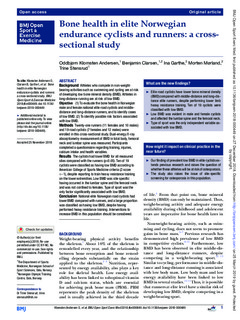| dc.contributor.author | Andersen, Oddbjørn Klomsten | |
| dc.contributor.author | Clarsen, Benjamin Matthew | |
| dc.contributor.author | Garthe, Ina | |
| dc.contributor.author | Mørland, Morten | |
| dc.contributor.author | Stensrud, Trine | |
| dc.date.accessioned | 2019-04-24T08:28:09Z | |
| dc.date.available | 2019-04-24T08:28:09Z | |
| dc.date.created | 2019-01-04T13:31:55Z | |
| dc.date.issued | 2018 | |
| dc.identifier.citation | BMJ Open Sport & Exercise Medicine. 2018, 4, e000449. | nb_NO |
| dc.identifier.issn | 2055-7647 | |
| dc.identifier.uri | http://hdl.handle.net/11250/2595186 | |
| dc.description | This is an open access article distributed in accordance with the Creative Commons Attribution Non Commercial (CC BY-NC 4.0) license, which permits others to distribute, remix, adapt, build upon this work non-commercially, and license their derivative works on different terms, provided the original work is properly cited, appropriate credit is given, any changes made indicated, and the use is non-commercial. See: http://creativecommons.org/licenses/by-nc/4.0/ | nb_NO |
| dc.description.abstract | Background: Athletes who compete in non-weight-bearing activities such as swimming and cycling are at risk of developing low bone mineral density (BMD). Athletes in long-distance running are at risk of low BMD. Objective: (1) To evaluate the bone health in Norwegian male and female national elite road cyclists and middle-distance and long-distance runners, and to identify cases of low BMD. (2) To identify possible risk factors associated with low BMD. Methods: Twenty-one runners (11 females and 10 males) and 19 road cyclists (7 females and 12 males) were enrolled in this cross-sectional study. Dual-energy X-ray absorptiometry measurement of BMD in total body, femoral neck and lumbar spine was measured. Participants completed a questionnaire regarding training, injuries, calcium intake and health variables. Results: The cyclists had lower BMD for all measured sites compared with the runners (p≤0.05). Ten of 19 cyclists were classified as having low BMD according to American College of Sports Medicine criteria (Z-score ≤−1), despite reporting to train heavy resistance training on the lower extremities. Low BMD was site specific having occurred in the lumbar spine and the femoral neck and was not confined to females. Type of sport was the only factor significantly associated with low BMD. Conclusion: National elite Norwegian road cyclists had lower BMD compared with runners, and a large proportion was classified as having low BMD, despite having performed heavy resistance training. Interventions to increase BMD in this population should be considered. | nb_NO |
| dc.language.iso | eng | nb_NO |
| dc.subject | bone mineral density | |
| dc.subject | energy deficits | |
| dc.subject | non-weight-bearing exercise | |
| dc.subject | weight-bearing exercise | |
| dc.title | Bone health in elite Norwegian endurance cyclists and runners: a cross-sectional study | nb_NO |
| dc.type | Journal article | nb_NO |
| dc.type | Peer reviewed | nb_NO |
| dc.description.version | publishedVersion | nb_NO |
| dc.rights.holder | © Author(s) (or their employer(s)) 2018. Re-use permitted under CC BY-NC. No commercial re-use. | nb_NO |
| dc.source.pagenumber | 7 | nb_NO |
| dc.source.volume | 4 | nb_NO |
| dc.source.journal | BMJ Open Sport & Exercise Medicine | nb_NO |
| dc.source.issue | 1 | nb_NO |
| dc.identifier.doi | 10.1136/bmjsem-2018-000449 | |
| dc.identifier.cristin | 1650445 | |
| dc.description.localcode | Seksjon for idrettsmedisinske fag / Department of Sport Medicine | nb_NO |
| cristin.unitcode | 150,34,0,0 | |
| cristin.unitname | Seksjon for idrettsmedisinske fag | |
| cristin.ispublished | true | |
| cristin.fulltext | original | |
| cristin.qualitycode | 1 | |
